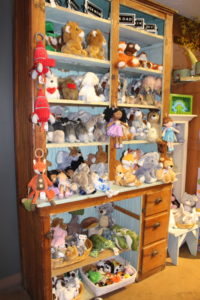Determining Your Profit Point
Want to hear a ridiculous fact? Many retailers don’t know the amount of sales they need to cover all of their expenses and pay themselves.
That is referred to as a break even analysis a ridiculous document.
Who wants to break even?
Instead, I create a Profit Point and Opportunity Analysis. You must know your profit point which includes ALL your expenses, salary and debt payments. Isn’t profit better than breaking even?
Do Some Calculating
Start by getting your financials together for the last two years. Let’s do your profit point for both years tosee how the numbers compare (see Figure 1).
Put in your sales, after returns and without sales tax. Don’t include sales tax because it’s not money that belongs to us.
COGS stands for the cost of goods sold without freight. Freight is not included here because it is actually an expense. It must be separated out from the amount you pay for inventory.

Then you know that number and can control the amount of money you spend on it.
Enter payroll without taxes. It includes everyone who works in the store, but not people who provide accounting, cleaning, merchandising or advertising.
When you enter rent, be sure to include taxes, CAM (common area maintenance) and anything else that you pay to your landlord.Let’s be clear on advertising and marketing. All expenses of an event are included; if you do a class, it includes all the drinks and food that you serve.
The only exception is if you sell those items in your store. Then, mark the items used down to zero and report them as a markdown; they don’t count in this expense.If you mail birthday cards, printing and postage is included.
Sometimes in a mall you have to pay advertising and marketing to your landlord. In that case, I take it out of the rent and include it in advertising and marketing for an accurate look at the numbers.
Finally, add all the other expenses from your profit and loss statement together.

One important point is often missed: there are expenses listed on your balance sheet. These are monthly payments made for assets or liabilities.
If they’re missed, you’re screwed.
Include debt payments, paying down your bank loan, paying down your home equity loan or if you have a line of credit for your home. Any payments like that are listed on your balance sheet because when you make a payment, the amount that shows as being due is decreased.
That’s why they call it a balance sheet expense. It also includes monthly payments to pay down a credit card balance that is outstanding.
It can get slightly confusing, so I want to make sure this is crystal clear.
Any monthly payments you make have to be included. I mentioned loan and credit card payments, but if you bought a car or a point of sale sy
stem through the store and have a monthly payment, that would go also under debt payments.

This is a critical part that many people don’t get.
Once you have all those numbers, add them up (see Figure 2). Add up COGS, payroll, rent, advertising/marketing, other expenses and debt payments. The total is the amount of sales that you must start at to generate more profit and more positive cash flow.
That is your profit point. It’s exhilarating to be able to know definitively where you move from breaking even into profit.
The number that will tell us the truth is your last year’s sales minus your profit point (see Figure 3).
OK, subtract the profit point from last year’s sales. If it’s a positive number, do the money dance!
If it’s a negative number, don’t despair. Don’t judge yourself. No negative self-talk. Instead, let’s fix it.
Have you been an ostrich? Sticking your head in the sand and avoiding this?
The problem with being an ostrich is you leave your back end out and up high as a great target to get hit. No matter what the number is, you know it now and can address it.
Real-Life Scenario
Let’s walk through an example with real numbers. You totaled your expenses and debt payments. Your total amount is $516,000.
This $516,000 is the amount of sales you’ve got to start at in order to generate profit and have a positive cash flow.
This is the moment of truth. Let’s say last year’s sales were $500,000. Subtract your total above from last year’s sales ($500,000 – $516,000).
Your profit point is $516,000; that means that you were short $16,000.
Like I said, no big deal, no judgment, it just is what it is and now you know to fix it. Numbers tell us the story of what needs to be fixed.
The problem is that too many people ignore them and that causes cash flow chaos and can force a premature going out of business sale.
Catch Cathy Wagner or numerous other speakers at the the Independent Retailer Conference events throughout the year.
As a retailer, it’s often hard to leave your business environment for any reason. After all, being at your store helps create the personality of your brand while also keeping your business operations alive and thriving.
Then again, getting away from your store is often the recipe for success that all retailers need to keep their stores relevant in a competitive retail environment.
Attending trade shows is a great excuse for this, but do you know what makes a trade show even more exciting? When they offer leading retail education that helps you bring insight, ideas and more back to your stores.
The Independent Retailer Conference delivers exactly this and more for attendees of each of their conferences throughout the year.
Held bi-annually at ASD Market Week, the Independent Retailer Conference is a unique learning environment that is held directly on the trade show floors of ASD and delivers education-rich, action-packed learning experiences.
Its goal? To engage, learn and connect retailers with industry experts such as Kizer & Bender, as well as connect merchants to service providers that have included Yelp, Square and Constant Contact.
Attendees of ASD Market Week are invited to attend over 50 educational sessions over the course of four days, helping them become better educated and more inspired in an effort to help their businesses thrive.
Camille Candella, market director of ASD Market Week, explains, “The Independent Retailer Conference is an added value to our attendees that we’re proud to offer as a complementary experience while attending ASD. We believe that education and retail resources can help merchants strengthen their individual store success, which is why we are big fans of what the Independent Retailer Conference brings to our shows.”
Learn more about the Independent Retailer Conference, their upcoming speakers, future show dates and more at www.indieretailerconference.com.


















 Videos
Videos





